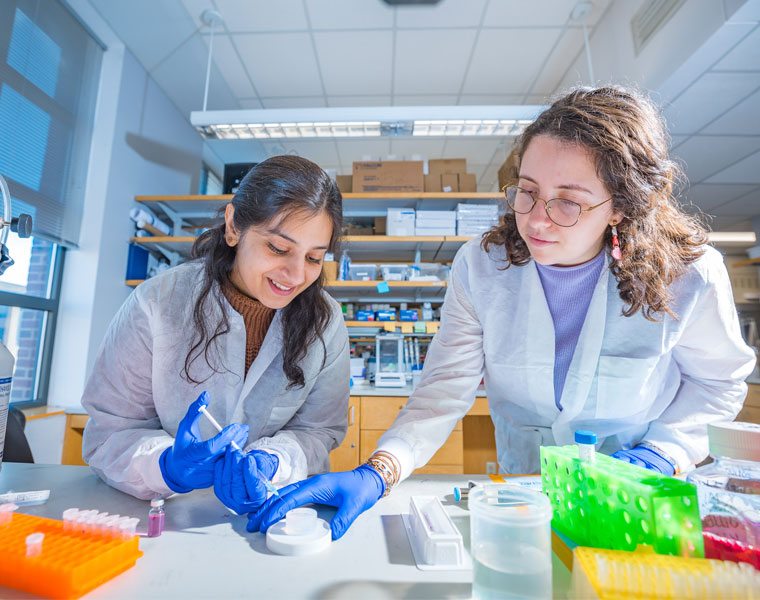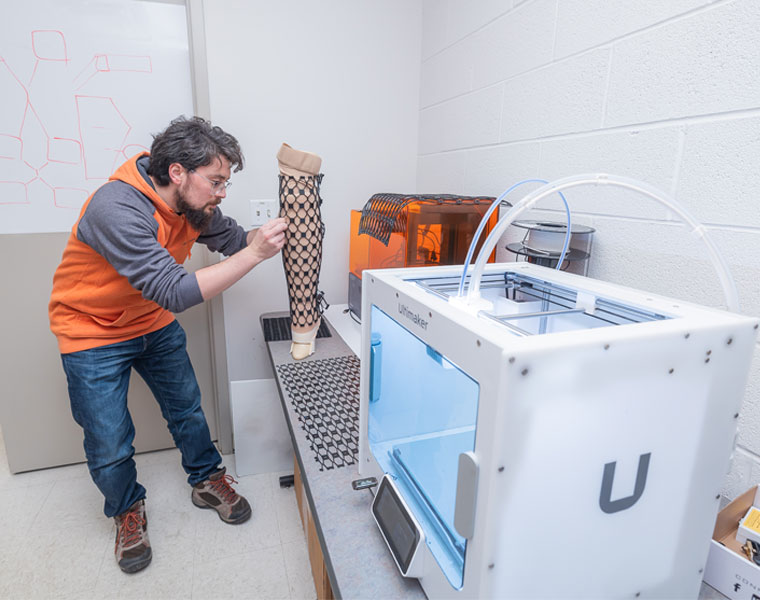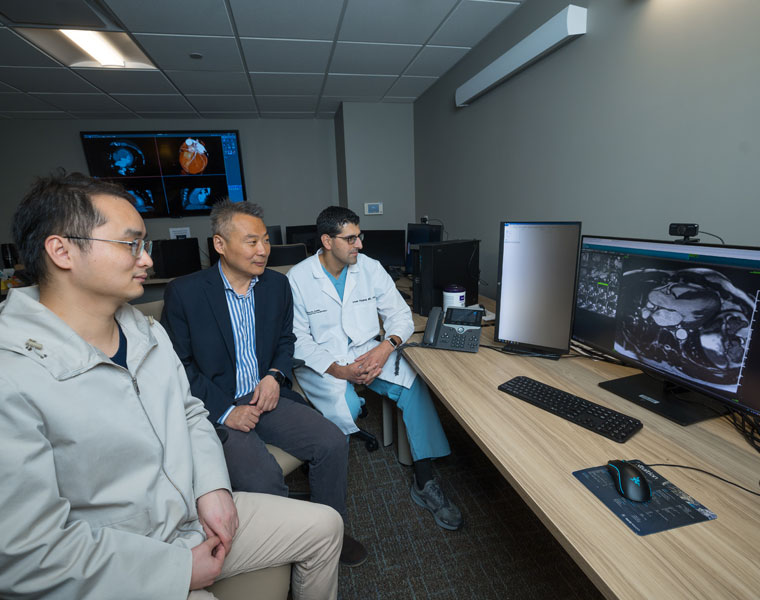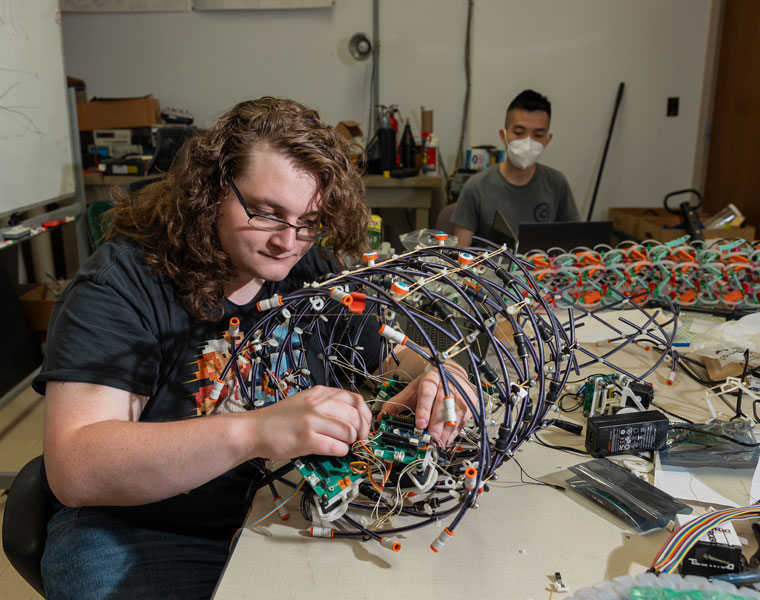Across the Case Western Reserve University campus, researchers drive discovery in a wide array of subjects—from engineering to medicine, nursing, social work, physics and beyond. Their work often takes place in laboratories, surrounded by high-tech computers or research equipment such as beakers, petri dishes or fume hoods.
In these spaces, faculty members, postdocs, lab assistants, and students at all levels—including high school students in some cases—come together to contribute to the teams’ efforts.
In honor of World Laboratory Day (April 23), we caught up with some faculty researchers to take a peek inside their spaces to find out what their teams are working on—and where they hope their efforts lead.
Answers have been lightly edited for clarity and length.
Agata Exner’s lab

Agata Exner, the Henry Willson Payne Professor and vice chair for basic research in the Department of Radiology, leads a laboratory at the School of Medicine. Her team develops contrast agents to use in ultrasound in tandem with analysis techniques to improve cancer diagnosis and treatment.
1. Can you describe your team’s research?
We design ultrasound contrast agents—or nanobubbles—which are made of a gas core surrounded by a lipid shell. When these bubbles come in contact with ultrasound waves, they expand and contract, which produces the contrast signal. These agents can be used to detect tumors by taking advantage of the fact that tumors have leaky vasculature compared to healthy tissue.
As a result, tumors appear “bright” due to the nanobubbles on ultrasound compared to healthy tissue making cancer diagnosis easier. We have multiple applications in the lab: pancreatic cancer, prostate cancer, diabetes, immunotherapy and gene delivery.
2. What is your hope for what your lab will accomplish?
A goal for the lab is the translation of nanoscale US contrast agents to clinical application. More broadly, we hope to inspire new applications of ultrasound in disease diagnosis and image-guided therapy. By doing so, we hope to make diagnostic imaging and these precision, personalized medicine approaches more accessible and affordable, and bring them to underserved populations both locally and globally. Imaging can greatly improve the patient experience and we think that ultrasound has the power to do this more so than any other imaging modality.
3. What is the best part about your lab?
I think that the best part of the lab is the collaborative attitude. There are many projects going on at any one time, but lab members are always willing to help troubleshoot, lend a hand, or talk through some science. It makes the lab a great place to work and conduct research. The lab is predominantly women, which sets a great example for women in STEM.
Ozan Akkus’s lab

Ozan Akkus, the Kent H. Smith Professor in the Department of Mechanical and Aerospace Engineering, operates a lab at Case School of Engineering. His team’s work focuses on biofabrication of functional biomaterials for repair and regeneration of tissues, such as bones, tendons and ligaments.
1. Can you describe your team’s research?
Collagen is the basic building block of the body, akin to bricks that make up construction. My lab invented methods to reconstitute collagen molecules as filaments that can be braided, knitted or woven as biotextiles, ones that can hold sutures for implantation and bear loads during function. Such textiles can virtually repair any form of sinew in our body.
We are particularly focused on repair of debilitating shoulder tendon injuries, and also making bioresorbable support materials to prevent urinary incontinence in females. Recently we are breaking ground to use such fabrics for growing cartilage tissue. This venue of research is multidisciplinary and it includes biologists and clinicians.
2. What is your hope for what your lab will accomplish?
It is important to me that our efforts have a translational perspective wherein our lab work evolves to become products that benefit patients. In that context, a startup company was spun off from our lab’s work and it has filed for the approval of its first product just this year.
It has been nearly a decade to get there and I am very excited with the possibility of our hard work that spans many lab members’ valiant efforts to give mobility back to people.
3. What is the best part about your lab?
I love the collaborative and collective teamwork toward a well-defined end-goal. Witnessing different lab members approaching a problem from different angles but in a complementary way has always amazed me.
The multidimensionality of the human mind and their convergence in the lab is what will carry us forward as mankind.
Shuo Li’s lab

Shuo Li, associate professor of biomedical engineering and computer and data sciences, leads a lab at Case School of Engineering working on artificial intelligence in biomedical imaging.
1. Can you describe your team’s research?
Our lab is at the forefront of integrating artificial intelligence with medical imaging. Our team is renowned for developing advanced machine-learning algorithms that enable new clinical applications that would significantly enhance imaging-centered clinical patient management capabilities.
These novel algorithms are adept at extracting detailed and precise information from medical scans such as MRIs and CTs, information that traditional methods might overlook. Our AI models facilitate more accurate and timely diagnoses and treatment by identifying subtle disease indicators early on. This advanced approach boosts diagnostic accuracy and helps clinicians devise more effective, personalized treatment strategies.
2. What is your hope for what your lab will accomplish?
As a global leader in AI-enhanced medical imaging, our lab is committed to maintaining and expanding our pioneering role. We strive to continually advance the development of technologies that elevate the precision of medical diagnostics and broaden the accessibility of these innovations to healthcare providers worldwide. Our efforts aim to make significant contributions to improving global health outcomes by enabling faster and more accurate medical interventions.
Furthermore, we are dedicated to cultivating the next generation of researchers and practitioners, arming them with the necessary expertise to propel ongoing innovation and apply AI to improve public health and well-being.
3. What is the best part about your lab?
The most rewarding aspect of our lab at Case Western Reserve University is the seamless, multidisciplinary environment we foster daily. My cross-appointment in the Department of Computer and Data Science (CDS) and the Department of Biomedical Engineering (BME) uniquely positions our team to bridge the gap between cutting-edge technology and clinical practice.
We collaborate closely with physicians each day to identify critical clinical challenges. This immediate and direct interaction allows us to translate these real-world problems into research objectives rapidly. Our team then works alongside experts in CDS and BME to develop innovative solutions that are both technologically advanced and clinically applicable. This dynamic, collaborative approach not only accelerates the pace of innovation but also enhances the impact of our research, making it deeply fulfilling and effective in advancing medical science.
Kathryn Daltorio’s lab

Kathryn Daltorio, associate professor of mechanical and aerospace engineering, leads a lab at Case School of Engineering that focuses on applied biorobotics.
1. Can you describe your team’s research?
Our goals are to learn from animals to make new and better robots.
2. What is your hope for what your lab will accomplish?
One example is to create crab robots that help clean up underwater unexploded ordnance.
3. What is the best part about your lab?
The students.
